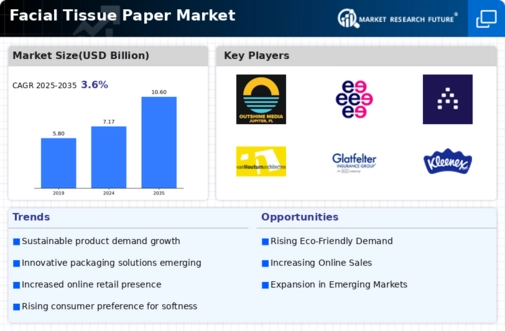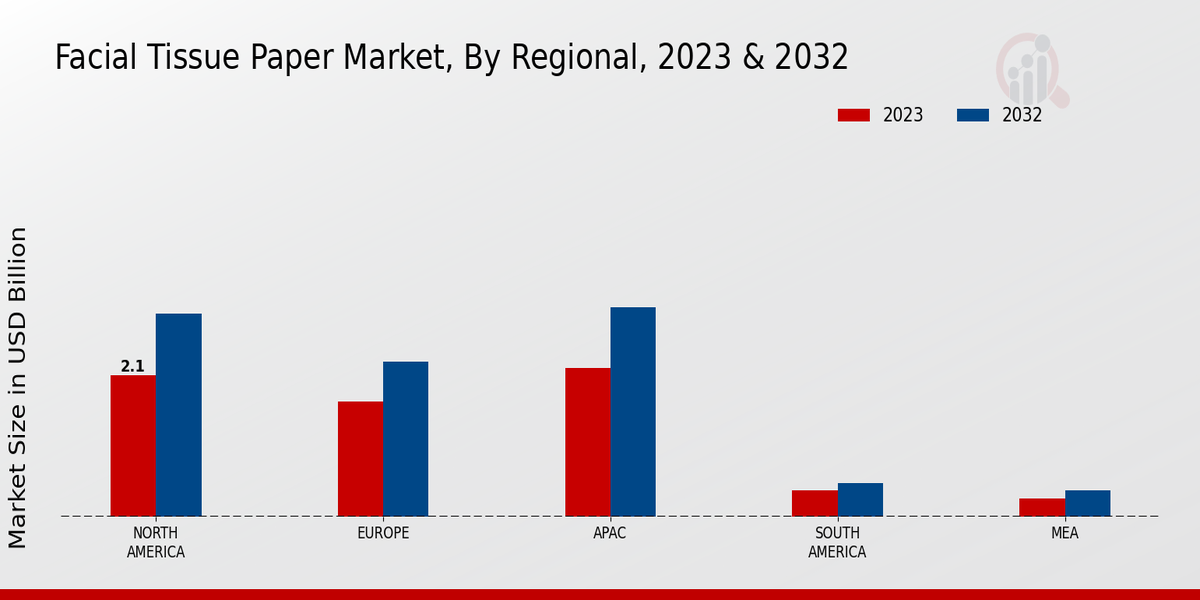E-commerce Growth
The rise of e-commerce is reshaping the Global Facial Tissue Paper Market Industry, providing consumers with greater access to a variety of products. Online platforms enable consumers to purchase facial tissues conveniently, often at competitive prices. This shift towards online shopping is particularly appealing to younger demographics, who prefer the ease of digital transactions. As e-commerce continues to expand, it is likely to drive sales in the facial tissue segment, contributing to the market's overall growth. The convenience and accessibility offered by online shopping platforms may enhance consumer engagement and loyalty, further propelling the market forward.
Sustainability Trends
Sustainability trends are significantly influencing the Global Facial Tissue Paper Market Industry, as consumers become more environmentally conscious. Manufacturers are increasingly adopting eco-friendly practices, such as using recycled materials and sustainable sourcing for raw materials. This shift not only caters to the growing demand for green products but also aligns with regulatory pressures aimed at reducing environmental impact. As a result, brands that prioritize sustainability are likely to gain a competitive edge, potentially leading to increased market share. The emphasis on eco-friendly products may drive the market's growth trajectory, contributing to the projected CAGR of 3.62% from 2025 to 2035.
Increasing Urbanization
The ongoing trend of urbanization is a significant driver for the Global Facial Tissue Paper Market Industry. As more individuals migrate to urban areas, the demand for convenient and portable hygiene products rises. Urban lifestyles often necessitate quick and efficient solutions for personal care, making facial tissues a preferred choice among consumers. This demographic shift not only increases the consumer base but also influences purchasing behaviors, with urban dwellers more inclined to invest in disposable hygiene products. Consequently, the market is expected to benefit from this trend, further solidifying its growth potential in the coming years.
Market Growth Projections
The Global Facial Tissue Paper Market Industry is projected to experience substantial growth, with estimates indicating a market value of 10.6 USD Billion by 2035. This anticipated growth reflects a compound annual growth rate (CAGR) of 3.62% from 2025 to 2035, suggesting a steady increase in consumer demand and market expansion. Factors such as rising disposable incomes, changing consumer preferences, and the ongoing focus on hygiene are likely to contribute to this upward trajectory. The market's growth projections underscore the potential for innovation and investment within the facial tissue segment, indicating a promising future for industry stakeholders.
Innovative Product Offerings
Innovation plays a crucial role in the Global Facial Tissue Paper Market Industry, as manufacturers continuously seek to differentiate their products. This includes the introduction of tissues with added features such as moisturizing agents, hypoallergenic properties, and enhanced softness. These innovations cater to diverse consumer preferences and needs, thereby expanding the market's reach. For instance, brands are launching facial tissues infused with aloe vera or other soothing ingredients, appealing to consumers seeking comfort and care. Such product diversification is likely to enhance consumer loyalty and drive sales, contributing to the overall growth of the market.
Rising Demand for Hygiene Products
The Global Facial Tissue Paper Market Industry experiences a notable increase in demand for hygiene products, driven by heightened awareness of personal cleanliness and health. Consumers are increasingly opting for facial tissues due to their convenience and effectiveness in maintaining hygiene. This trend is particularly evident in urban areas where lifestyles are fast-paced, and the need for portable hygiene solutions is paramount. As a result, the market is projected to reach 7.17 USD Billion in 2024, reflecting a growing consumer preference for disposable hygiene products. This shift indicates a robust potential for growth within the Global Facial Tissue Paper Market Industry.























